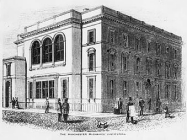By the late 1840s Britain entered into a second phase of industrialisation. The construction of the railway network, almost complete by 1847, had stimulated the growth of the coal, iron and (later) steel and engineering industries. Together with cotton, these formed Britain's staple industries. Until the 1870s they flourished in a unique period of steady uninterrupted growth, punctuated only by the two short depressions in 1857 and 1866. Reaping the benefit of her early industrial lead, Britain had acquired a monopoly of world trade - she had literally become 'the workshop of the world'.
'New Model' unionism
Many workers in the profitable staple industries benefited from the new boom conditions. Sometimes referred to as an 'aristocracy of labour', such workers were the backbone of the trade union revival which followed the demise of Chartism. It was very different from the trade unionism of the earlier period. Most of the so-called new unions were re-formations of already existing (usually) craft organisations. These new unions, like the Amalgamated Society of Engineers (ASE) 1851 (the 'model' on which others were based), were organised nationally and highly centralised. They levied high membership dues and hence were able to employ full time officials and offer improved 'friendly society' benefits.
Negotiation and arbitration gradually came to be accepted practices and were a much more common means of securing improvements in wages and conditions than strike action. Strikes did take place (for example the engineers' strike of 1852 and the protracted London builders' strike of 1859-60), but caution was to be exercised in the use of the "double edged (strike) weapon" (Robert Applegarth, secretary of the Amalgamated Society of Carpenter and Joiners).
The smaller craft unions like those of the tailors and shoemakers, whilst not 'new model' in their organisational form, shared a similar ideology. George Potter, editor of the trade union paper 'The Beehive' was the spokesman for these and the northern unions. In 1850, there were roughly 100,000 trade union members. By 1874, this figure as represented at the Trades Union Congress that year had risen to over a million. Thereafter there was a sharp decline in membership, reflecting the strong associations of this type of trade unionism with Britain's economic fortunes. In 1872, Joseph Arch's attempt to organise agricultural workers met with initial success, but this too was short lived.
Women were excluded from most of these 'craft' unions. The only trade in which they still remained organised in any numbers was that of weaving. Any attempts to organise women in this period came from outside the labour movement, often through the work of philanthropic women. The most notable example is the formation in 1874 of the Women's Protective and Provident League (later the Women's Trade Union League).
The London Trades Council, formed in 1860 as a result of a building workers' dispute, brought together many of the London based leaders of trade unions. However, it was not until 1868 that the Trades Union Congress was founded. Its first congress was convened by the Manchester and Salford Trades Council. Trade unions were quick to exploit the new opportunities presented by the extension of the franchise in 1867 to better paid urban male workers by taking on some of the functions of a parliamentary pressure group. Hence the TUC's Parliamentary Committee was formed in 1871. This was the forerunner of the General Council.
After the 1867 Reform Act, both Liberal and Tory governments showed interest in trade unions. Two Royal Commissions were established in the space of seven years. The first, in 1867, was to enquire into the Trade Unions, following the so-called Sheffield 'outrages' (when unions were accused of using arson and murder to intimidate non-unionists) and the second, on Labour Laws, was appointed in 1874. Of the six major pieces of factory/trade union/industrial relations legislation passed as a result, the main consequence was that the status of trade unions, although not their power, was enhanced. The Employers and Workmen Act 1875 modified the old Master and Servant Law so that employers too could be sued for breach of contract. The 1874 Factory Act set a ten-hour limit on the working day - the unions were campaigning for eight. The 1871 Trade Union Act recognised unions as legal entities as corporations and as such they were entitled to protection under the law. (This provided an end to the anomaly revealed by the Hornby vs Close case, in which it was deemed not to be unlawful to abscond with the funds of a union- in this case the Boilermakers). The question as to whether unions could in practice take effective strike action by picketing the workplace was the subject of much controversy. Interestingly, it was a Liberal government which criminalised picketing, (1871 Criminal Law Amendment Act), and a Tory government which de-criminalised it (1875 Conspiracy and Protection of Property Act).
The working class vote was important to both parties and the Tories were as keen as the Liberals to use it to advantage. The Liberal Party strategy of 'lib-labism' (supporting working men as parliamentary candidates in selected constituencies) resulted in the return of a miner, Thomas Burt, as the Liberal MP for Morpeth, and Alexander McDonald (secretary of the National Miners' Association) as Liberal MP for Stafford in the 1874 election.
Therefore by the 1880s, a strong, although narrowly based trade union movement had been created, but there were stirrings of a challenge. The boom was over and the ensuing depression questioned the complacency of the self-help ideal.
Professor Mary Davis, Centre for Trade Union Studies, London Metropolitan University
Back to top







